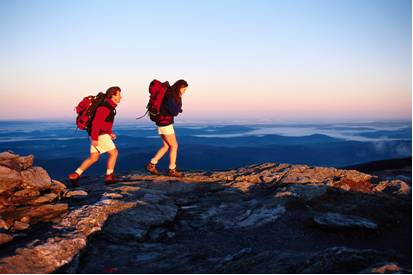 The 2013 Adventure Tourism Market Study uses the same methodology and approach as the 2010 study allowing for direct comparison between the studies and growth trend analysis. It included three key outbound regions: Europe, North America and South America. These regions account for nearly 70 percent of overall international departures, according to the United Nations World Tourism Organization (UNWTO). The study estimates the value of the global outbound adventure travel sector to be US$263 billion, excluding airfare, up from US$89 billion first reported in the benchmark consumer study. When this US$263 billion is combined with the estimated $82 billion spent for related gear, apparel and accessories, adventure travelers spent more than $345 billion in 2012 for travel related to adventure.
The 2013 Adventure Tourism Market Study uses the same methodology and approach as the 2010 study allowing for direct comparison between the studies and growth trend analysis. It included three key outbound regions: Europe, North America and South America. These regions account for nearly 70 percent of overall international departures, according to the United Nations World Tourism Organization (UNWTO). The study estimates the value of the global outbound adventure travel sector to be US$263 billion, excluding airfare, up from US$89 billion first reported in the benchmark consumer study. When this US$263 billion is combined with the estimated $82 billion spent for related gear, apparel and accessories, adventure travelers spent more than $345 billion in 2012 for travel related to adventure.
?Adventure tourism?s steep climb is attributed to growth in the global tourism industry, a significant increase in the percentage of adventure travelers, and an increase in the average amount spent per adventure travel trip,? said ATTA President Mr. Shannon Stowell. ?This comes as positive news, of course, and reinforces the ATTA community?s rising commitment to safety, education, training and development of innovative and culturally and environmentally sound travel options. As we watch adventure travel tourism grow it is imperative that we continue to provide travelers with transformative experiences, all while helping to protect and respect the very people and places visited.?
The GW/ATTA?s market value results reflect the growth in the international tourism market which reached an all-time record of more than one billion international tourism arrivals in 2012, as reported by the UNWTO. As UNWTO Secretary-General Taleb Rifai said at the 2012 Adventure Travel World Summit, ?Adventure tourism is what tourism should be today and definitely what tourism will be tomorrow.?
Also viewed as a key contributor to this significant growth pattern is the increase in the percentage of European and South American travelers classified as adventure travelers, an increase in the average spending by adventure travelers globally ($593 per trip in 2009 to $947 in 2012), recovery from the global financial crisis, and the emergence of new source markets.
The ATTA defines a trip as ?adventure travel? if it involves two of the following three elements, with the core of an adventure trip involving all three:
- connection with nature,
- interaction with culture, and
- a physical activity.
In the 2013 Market Study respondents were asked specifically if they had participated in an adventure activity on their last trip. Example activities included soft adventure options such as hiking, kayaking, rafting, snorkeling, volunteer tourism and archaeological expeditions and hard adventure options such as caving, climbing, heli-skiing, kite surfing, trekking and paragliding.
Further highlights from the Adventure Tourism Market Study include:
? ???Adventure travelers are younger than non-adventure travelers, with an average age of 36;
? ???In 2012 nearly 42 percent of travelers from these three regions reported an adventure activity as the main activity of their last trip (the activity would have been one of those identified in the survey as hard or soft adventure options);
? ??The average length of a soft adventure trip was ten days in 2012 compared to eight days in 2009;
? ???Adventure travelers read publications such as National Geographic, National Geographic Traveler and Men?s Health, which cover traditional adventure and recreation topics, as well as unrelated but popular publications such as Cosmopolitan and Vogue;
? ???Nearly 54 percent of travelers plan to participate in an adventure activity on their next trip, compared to the 42 percent of travelers currently participating in adventure activities. The increase in interest comes largely from soft adventure activities;
? ??73 percent of adventure travelers plan to participate in an adventure activity on their next trip. Only 22 percent of adventure travelers plan on doing the same adventure activity as their last trip;
? ??45 percent of adventure travelers plan on using a tour operator on their next trip, compared to only 31 percent of non-adventure travelers;
? ??The percentage of adventure travelers using Facebook (78 percent) has more than doubled since 2009.
The Adventure Tourism Market Study is a barometer for the size and characteristics of the adventure tourism market. Adventure travel is a sector of tourism increasingly recognized for attracting environmentally and culturally aware consumers and for its focus on responsible and sustainable development, a model designed to create economic opportunities for local people in rural and remote communities worldwide.
Information available in the Adventure Tourism Market Study is expected to aid the adventure travel industry, destinations looking to build or enhance their adventure offerings, and adventure tourism operators seeking to better understand their target market. Comparing these findings with recent ATTA adventure tourism trade studies also reveals important differences between the expenditures of guided and un-guided adventure travelers. For example, ATTA Members? customers spend approximately $3,000 per person per trip (excluding airfare and gear), roughly three times higher than the independent adventure traveler.
Click here to read more.

